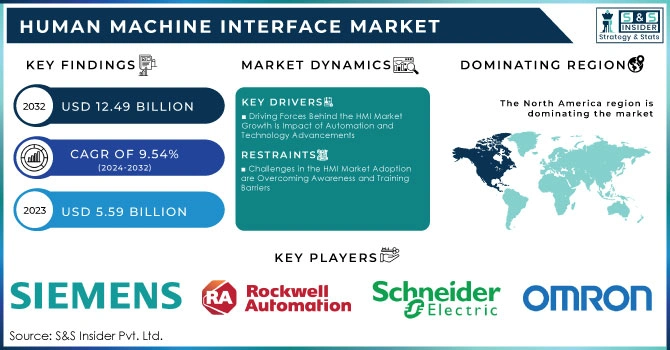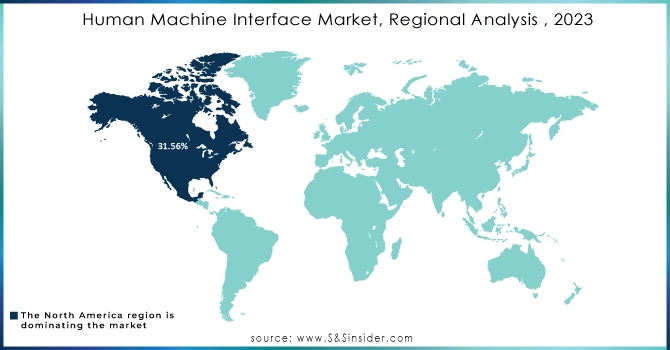Human Machine Interface Market Report Scope & Overview:

Get More Information on Human Machine Interface Market - Request Sample Report
The Human Machine Interface Market Size was valued at USD 5.59 Billion in 2023 and is expected to reach USD 12.49 Billion by 2032 and grow at a CAGR of 9.54% over the forecast period 2024-2032.
The Human Machine interface market is growing due to automation in various industries. Needing to improve efficiency and reduce operational costs, businesses are embracing advanced HMI solutions that enable operators to communicate with machines seamlessly. This trend has become more and more pronounced in manufacturing, automotive, and healthcare sectors wherein HMI plays a critical role in monitoring and controlling quite complex processes. Technological advancements are also giving a much-needed boost to HMIs with the assistance of IoT and artificial intelligence. HMI devices today, for instance, come embedded with touchscreens, voice recognition, and gesture control and focus on being intuitive and user-friendly devices that can improve productivity and safety in organizations.
The industry has witnessed several technology upgrades, from the indication of Light Emitting Diode (LED) to fully functional touchscreen and graphics-oriented terminals. The products equipped with Bluetooth and Wi-Fi have improved device mobility. This trend is expected to drive demand in the forecast period as well. With huge growth prospects, rising demand for high-resolution screens to analyze processes properly sustains growth. Add to that is the continuous updating and up-gradation of computer processors, which would come to replace the traditional systems, thereby augmenting the demand for products. With advancements in broadband access technology, it is expected to open immense growth opportunities during the next seven years. Global smartphone shipments were 1.14 billion units, primarily touch-enabled. Compared with shipments in 2022, sales were 4% lower. The sales leader was Apple at 229.2 million units, followed by Samsung at 225.4 million units. These sales emphasize the adoption of human-machine interface technologies such as touch functionality in mobile handsets and highlight their use in everyday interactions
Human Machine Interface Market Dynamics
Key Drivers:
-
Driving Forces Behind the HMI Market Growth Is Impact of Automation and Technology Advancements
The need for automation in most industries is the primary driver of the HMI market. Most businesses seek how they can improve efficiency, reduce the costs of operations, and increase productivity. It is these primary factors that drive businesses toward automated solutions, in which HMIs are critical tools enabling operators to monitor and control complex machinery and processes with ease. Advanced HMI systems are more or less an integration necessity in sectors such as manufacturing, automotive, and healthcare, where precision and reliability are cardinal. Such a shift towards automation is not only streamlining operations but also helping companies respond rapidly to market demands and hold their own in the competition. Technological advancements are hugely influencing the functionality and user experience of HMI systems and are fast gaining ground.
-
Transforming HMIs Through Cutting-Edge Technologies and the Rise of Intuitive Interfaces and Data Analytic.
The innovations regarding the Internet of Things (IoT), artificial intelligence, and data visualization are allowing traditional HMIs to be transformed into sophisticated user-friendly interfaces. Modern HMI incorporates intuitive touch screens, voice recognition, and gesture control. Interactions are now seamless and efficient. Moreover, the growing emphasis on data analytics provides a clear view of real-time information and insight for decision-making purposes. As industries continue embracing these technological advancements, advanced HMI solutions that allow for high-level performance at reduced costs will be in demand and driving the market forward.
Restrain:
-
Challenges in the HMI Market Adoption are Overcoming Awareness and Training Barriers
The main restraint exerted on the market of Human Machine Interface is the lack of awareness among potential users about HMI technologies, and many organizations do not have proper knowledge regarding the implementation and usage of advanced HMI systems, resulting in reluctance towards adopting new technologies. Moreover, specific training for the operators may discourage companies from investing in HMI solutions as the process will be perceived to be costly. Awareness and training disparity is one of those gaps that slow the widespread adoption of HMI technologies leading to slowed market growth in most industries.
Human Machine Interface Market Segmentation Overview
By Product
The interface software segment held the highest share of 39.87% in the market in 2023. Interface software is largely used to interchange information between different computer system components. Betterment in the application development process may lead to the diminishment of the size of applications and speeds of computing.
The display segment is expected to register the largest CAGR of 11.08% during the forecast period. Industrial automation systems make heavy use of display terminals and interface software. The technological progress changed from the traditional Cathode Ray Tube (CRT)-based video terminals to innovative TFT-based capacitive displays. Apart from the capacitive display, LED and LCD-based UHD displays are also likely to serve as avenues for industry growth.
By Application
The automotive segment remained the largest with 51.56% revenue market share in 2023. Of course, the car showroom has also remodeled the layout of the car dashboard as well into a more flexible, dynamic, and adaptive design due to advanced technology. Standalone systems might increase safety risks, but in an integrated form with HMIs, speech input/output may reduce driver distraction when commanding vehicles and speed up the growth of this industry.
The oil and gas segment industry is expected to expand at a healthy CAGR of 11.17% in the forecasting period. HMIs for this industry are developing quickly to provide more advanced data visualization and analytics capabilities. Advanced HMIs help operators view, understand, and interpret huge amounts of complex data while tracking critical key performance metrics. They also allow real-time identification of patterns or anomalies within data, thus supporting data-driven decision-making and optimizing operational performance.
Human Machine Interface Market Regional Analysis
North America held the largest market share of 31.56% in the base year, primarily because technology had been adopted much earlier. The number of automation projects is also likely to rise and will have a great influence on regional demand in the forecast period. Industrial base diversified and strong manufacturing, auto, aerospace, energy, and health service sectors are present in the region. Such industries need highly sophisticated Human Machine Interfaces to rationalize their processes, increase productivity, and enhance the user experience. This reason therefore makes North America remain one of the primary markets for HMI solutions.
The Asia-Pacific region is expected to experience the highest CAGR of 10.50% during the forecast period. The rapid industrialization in this region works as a major growth driver for the HMI market. Besides, the raw materials are abundantly available and there exists a low-cost labor force in the region, which in turn fuels the demand for HMI solutions. This marks a harbinger for the Asia-Pacific region to become one of the main drivers in the expansion of the HMI market.

Need Any Customization Research On Human Machine Interface Market - Inquiry Now
Key Players in Human Machine Interface Market
Some of the major players in the Human Machine Interface Market are:
-
Siemens (SIMATIC HMI, WinCC),
-
Rockwell Automation (FactoryTalk View, Allen-Bradley),
-
Schneider Electric (Magelis HMI, EcoStruxure),
-
Mitsubishi Electric (GT Works3, GOT2000),
-
Honeywell (Experion HMI, Process Solutions),
-
Yokogawa Electric (ProSafe HMI, Stardom),
-
ABB (Ability HMI, Control System),
-
Omron (NS Series, FQ-M Series),
-
GE Digital (iFIX, Proficy HMI/SCADA),
-
Beckhoff Automation (TwinCAT HMI, CP Series),
-
Advantech (WebAccess HMI, ADAM Series),
-
B&R Industrial Automation (APROL HMI, Automation Studio),
-
Delta Electronics (DOP Series, WPLSoft),
-
KUKA (KUKA SmartPAD, KUKA.VisionTech),
-
Inductive Automation (Ignition, Vision Module),
-
Phoenix Contact (Visual Control, ILC Series),
-
CODESYS (CODESYS Visualization, CODESYS HMI),
-
Siemens AG (Siemens S7-1200 HMI, SIMATIC Comfort Panels),
-
Pro-face (GP Series, LT Series),
-
Weintek (MT8000 Series, cMT Series)
Recent Trends
-
In July 2024, Mouser Electronics, Inc., a global leading authorized distributor of the newest semiconductors and electronic components as well as industrial automation products, announced the latest installment of its Empowering Innovation Together (EIT) technology series.
-
In Sep 2024, EAO stands out as a specialized supplier for railway applications –the company product portfolio encompasses complex HMI systems that support from project initiation to implementation with comprehensive advice and technical expertise.
-
In August 2024, A new brain-computer interface (BCI) developed at UC Davis Health translates brain signals into speech with up to 97% accuracy — the most accurate system of its kind.
| Report Attributes | Details |
|---|---|
| Market Size in 2023 | USD 5.59 Billion |
| Market Size by 2032 | USD 12.49 Billion |
| CAGR | CAGR of 9.38% From 2024 to 2032 |
| Base Year | 2023 |
| Forecast Period | 2024-2032 |
| Historical Data | 2020-2022 |
| Report Scope & Coverage | Market Size, Segments Analysis, Competitive Landscape, Regional Analysis, DROC & SWOT Analysis, Forecast Outlook |
| Key Segments | • By Product (Display Terminals, Interface Software, Industrial PCs, Others), • By Application (Automotive, Food and Beverages, Oil and Gas, Packaging, Others) |
| Regional Analysis/Coverage | North America (US, Canada, Mexico), Europe (Eastern Europe [Poland, Romania, Hungary, Turkey, Rest of Eastern Europe] Western Europe] Germany, France, UK, Italy, Spain, Netherlands, Switzerland, Austria, Rest of Western Europe]), Asia Pacific (China, India, Japan, South Korea, Vietnam, Singapore, Australia, Rest of Asia Pacific), Middle East & Africa (Middle East [UAE, Egypt, Saudi Arabia, Qatar, Rest of Middle East], Africa [Nigeria, South Africa, Rest of Africa], Latin America (Brazil, Argentina, Colombia, Rest of Latin America) |
| Company Profiles | Siemens, Rockwell Automation, Schneider Electric, Mitsubishi Electric, Honeywell, Yokogawa Electric, ABB, Omron, GE Digital, Beckhoff Automation, Advantech, B&R Industrial Automation, Delta Electronics, KUKA, Inductive Automation, Phoenix Contact, CODESYS, Pro-face, Weintek |
| Key Drivers | • Driving Forces Behind the HMI Market Growth Is Impact of Automation and Technology Advancements • Transforming HMIs Through Cutting-Edge Technologies and the Rise of Intuitive Interfaces and Data Analytic. |
| RESTRAINTS | • Challenges in the HMI Market Adoption are Overcoming Awareness and Training Barriers |

